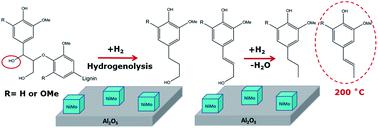当前位置:
X-MOL 学术
›
Sustain. Energy Fuels
›
论文详情
Our official English website, www.x-mol.net, welcomes your
feedback! (Note: you will need to create a separate account there.)
Solvent assisted catalytic conversion of beech wood and organosolv lignin over NiMo/γ-Al2O3
Sustainable Energy & Fuels ( IF 5.0 ) Pub Date : 2020-01-30 , DOI: 10.1039/c9se00375d Soheila Ghafarnejad Parto 1, 2, 3, 4 , Emma Kathrine Jørgensen 1, 2, 3, 4 , Jakob Munkholt Christensen 1, 2, 3, 4 , Lars Saaby Pedersen 3, 4, 5 , Daniel Bo Larsen 2, 3, 4, 6 , Jens Øllgaard Duus 2, 3, 4, 6 , Anker Degn Jensen 1, 2, 3, 4
Sustainable Energy & Fuels ( IF 5.0 ) Pub Date : 2020-01-30 , DOI: 10.1039/c9se00375d Soheila Ghafarnejad Parto 1, 2, 3, 4 , Emma Kathrine Jørgensen 1, 2, 3, 4 , Jakob Munkholt Christensen 1, 2, 3, 4 , Lars Saaby Pedersen 3, 4, 5 , Daniel Bo Larsen 2, 3, 4, 6 , Jens Øllgaard Duus 2, 3, 4, 6 , Anker Degn Jensen 1, 2, 3, 4
Affiliation

|
Beech wood was directly converted into lignin derived monomers and dimers and holocellulose derived light hydrocarbons in the presence of a sulfided NiMo/γ-Al2O3 catalyst in ethanol medium at 200 to 300 °C. The reaction products were carefully analyzed with techniques such as gas chromatography mass spectrometry equipped with a flame ionization detector (GC-MS-FID), size exclusion chromatography (SEC), elemental analysis and heteronuclear single quantum coherence nuclear magnetic resonance (HSQC NMR). The main identified monomers obtained at 300 °C were 4-propyl guaiacol (PG) and 4-propyl syringol (PS) with a total monomer yield of 18.1 wt% based on the Klason lignin content in beech wood. At a lower reaction temperature of 200 °C, the process targets only the lignin with a monomer yield of 12.1 wt% based on the Klason lignin content, while the holocellulose is conserved and can be used for a subsequent fermentation or hydrocracking process. The highest monomer yield of 20.0 wt% based on the Klason lignin content was obtained at 260 °C, indicating that the optimum temperature required for degradation of lignin fractions to monomers is within 200–260 °C. The direct conversion of biomass with high yield of lignin monomers showed promise compared to a two-step process involving initial isolation of lignin by the organosolv method and subsequent conversion of organosolv lignin. Here, a monomer yield of only 4.3 wt% was detected at 300 °C. Moreover, the oil from the direct biomass conversion possessed a lower molecular weight compared to the oil from the organosolv lignin conversion.
中文翻译:

NiMo /γ-Al2O3上的溶剂辅助催化榉木和有机溶剂木质素的催化转化
榉木是直接转换成木质素衍生的单体和二聚体和综纤维素衍生的轻质烃中的硫化的NiMo /γ-Al系存在2 ö 3催化剂在200至300°C的乙醇介质中。使用配备有火焰离子化检测器(GC-MS-FID)的气相色谱质谱,尺寸排阻色谱(SEC),元素分析和异核单量子相干核磁共振(HSQC NMR)等技术对反应产物进行仔细分析。在300°C下获得的主要鉴定单体为4-丙基愈创木酚(PG)和4-丙基丁香酚(PS),基于榉木中Klason木质素的含量,总单体产率为18.1 wt%。在200°C的较低反应温度下,该工艺仅针对木质素,基于Klason木质素含量,单体收率为12.1 wt%,而全纤维素则可以保留,可用于后续的发酵或加氢裂化工艺。最高单体产量为20。基于Klason木质素含量的0 wt%是在260°C下获得的,表明木质素级分降解为单体所需的最佳温度在200–260°C之内。与包括通过有机溶剂法初步分离木质素并随后转化有机溶剂木质素的两步法相比,具有高产率的木质素单体的生物质的直接转化显示出希望。在此,在300℃下仅检测到4.3重量%的单体产率。而且,与来自有机溶剂木质素转化的油相比,来自直接生物质转化的油具有较低的分子量。与包括通过有机溶剂法初步分离木质素并随后转化有机溶剂木质素的两步法相比,具有高产率的木质素单体的生物质的直接转化显示出希望。在此,在300℃下仅检测到4.3重量%的单体收率。而且,与来自有机溶剂木质素转化的油相比,来自直接生物质转化的油具有较低的分子量。与包括通过有机溶剂法初步分离木质素并随后转化有机溶剂木质素的两步法相比,具有高产率的木质素单体的生物质的直接转化显示出希望。在此,在300℃下仅检测到4.3重量%的单体收率。而且,与来自有机溶剂木质素转化的油相比,来自直接生物质转化的油具有较低的分子量。
更新日期:2020-01-30
中文翻译:

NiMo /γ-Al2O3上的溶剂辅助催化榉木和有机溶剂木质素的催化转化
榉木是直接转换成木质素衍生的单体和二聚体和综纤维素衍生的轻质烃中的硫化的NiMo /γ-Al系存在2 ö 3催化剂在200至300°C的乙醇介质中。使用配备有火焰离子化检测器(GC-MS-FID)的气相色谱质谱,尺寸排阻色谱(SEC),元素分析和异核单量子相干核磁共振(HSQC NMR)等技术对反应产物进行仔细分析。在300°C下获得的主要鉴定单体为4-丙基愈创木酚(PG)和4-丙基丁香酚(PS),基于榉木中Klason木质素的含量,总单体产率为18.1 wt%。在200°C的较低反应温度下,该工艺仅针对木质素,基于Klason木质素含量,单体收率为12.1 wt%,而全纤维素则可以保留,可用于后续的发酵或加氢裂化工艺。最高单体产量为20。基于Klason木质素含量的0 wt%是在260°C下获得的,表明木质素级分降解为单体所需的最佳温度在200–260°C之内。与包括通过有机溶剂法初步分离木质素并随后转化有机溶剂木质素的两步法相比,具有高产率的木质素单体的生物质的直接转化显示出希望。在此,在300℃下仅检测到4.3重量%的单体产率。而且,与来自有机溶剂木质素转化的油相比,来自直接生物质转化的油具有较低的分子量。与包括通过有机溶剂法初步分离木质素并随后转化有机溶剂木质素的两步法相比,具有高产率的木质素单体的生物质的直接转化显示出希望。在此,在300℃下仅检测到4.3重量%的单体收率。而且,与来自有机溶剂木质素转化的油相比,来自直接生物质转化的油具有较低的分子量。与包括通过有机溶剂法初步分离木质素并随后转化有机溶剂木质素的两步法相比,具有高产率的木质素单体的生物质的直接转化显示出希望。在此,在300℃下仅检测到4.3重量%的单体收率。而且,与来自有机溶剂木质素转化的油相比,来自直接生物质转化的油具有较低的分子量。











































 京公网安备 11010802027423号
京公网安备 11010802027423号